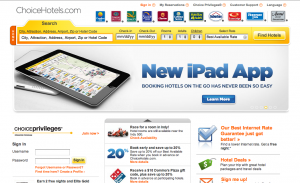If you missed Part I of this two-part Q&A, check that out here. Here’s the second installation – enjoy!
In the below Q&A, Chris Brya, Director, Mobile & Emerging Channels, Choice Hotels, talks about how to apply analytics to your mobile programs and how deep to delve. He also gives tips on how to work with vendors to create win-win situations for both your organization and theirs.
Kelly: How deep do you think companies should delve into mobile analytics when they start? Let’s say you are a company that doesn’t have really anything going on in mobile but you really want to make sure you’re getting a wide grasp of everything that’s happened with it. Do you recommend going full force in analyzing every little thing that a customer is doing, or just kind of taking a broad brush and going over, “Okay well, how long are they visiting the site,” those sort of simple analytics? How deep should these analytics get?
Chris: If you’re starting from scratch, I think the first thing you need to do is find out who your mobile customers are. And sometimes that might have to just be…let’s know first what our desktop customers like, and then what can we ascertain from that what might make mobile sense.
Then once you define who your customers are, then you ask, ‘What is it that you want to be able to do with this mobile journey?’ Sometimes it’s, you know…in our case, we want to drive direct distribution. We want people to book hotel rooms. But that’s not the only thing. If you’re a company that is just using it for regeneration or you’re, say, ESPN, you want to show real live video of what games are going on right then and there. What’s important to your customer is going to vary. But you need to be able to figure out who that is, who that customer is and what you’re trying to achieve there, and then you can kind of lay out what your strategy is. If you start throwing darts on the board, it gets expensive quick. The success you’re going to have in defining your strategy early on depends on defining who your customer is, what you’re trying to achieve, and then getting into, “How are we going to measure this?” and then the technology part is actually the last.
Kelly: As far as goals go, would you say there are certain kinds of goals that might lend themselves to deeper analytics? Say your goals are straight up revenue; you really just want to get more revenue out of this channel. Does that therefore lead you to a better analytics package? When do you decide to really take that move and say, “I need a full service analytics package tracking everything that’s happening here,” versus, “I just need some sort of overall understanding of the engagement of the customers?”
Chris: I think that any measurement is better than no measurement. You have to start there. So if you have a mobile program that’s already launched, what numbers can you glean from that right now? The more you’re going to get, the more ammunition you’re going to receive. How do you expand this any further? We use an analytics package for the desktop and we apply that to mobile so that we can see the analog of our desktop site in mobile and figure out how those customers are interacting. Where we’re doing things a little bit better in mobile, where we are doing some things that may be better in the desktop, and how can we leverage the two because even though we’re doing the same thing – we’re selling hotel rooms – the process and the need for those customers from the desktop web and mobile web, are different.
Kelly: You talked a little about vendors and how this is an evolving landscape; everybody has stuff to learn from one another. You brought up the point that you really have to be able to work with your vendors and say, “You know, this is what we need.” How do you do that, and why do you think that that’s so important? Do you think that vendors will actually evolve with us?
Chris: I think that they’re going to have to. I mean, this mobile shift is already taking place. So one of the things that we did is, we have strategic vendors that are important for us in the desktop channel. We go to them and say, “Hey, we’re looking to do the same thing in mobile. What can you do to support that?” Sometimes they have some things in the works. Sometimes they don’t. And often times it’s the instances where they say, “You know, you’re the fourth company that asked me about that,” that they start getting the idea that – we need to get involved here. And then what I offer is, “Hey, would you be interested in doing a pilot? We’re a company that might be willing to pilot out a beta launch. Or it is something that you’re working on in mobile?” And along with that it starts to become a nice relationship build – they get information about how to make the product in mobile and we get information that we’re looking for. It’s kind of a win-win situation.
Kelly: You had an example of that that you spoke about. Could you mention it here?
Chris: Yes. We have a company that does survey work for us on our desktop called iPerceptions. And with iPerceptions we were talking and we said, “You know, we’re about to launch – we’ve launched a mobile channel and we’d like to leverage some of the pieces that you’re offering on the desktop in a mobile fashion.” And they said, “You know, it’s funny you say that ‘cause we’re looking at doing exactly that.” And so we asked how far along they were and they were just getting started. They started asking those questions and we started saying, “If we are going to do this, we’d want it to work like this and we want it to operate like that. Here are my needs as your customer.” And they really took that to heart, and so they’re actually working on a program right now for us that they could roll out in some beta tests. So it was a win-win for everybody and I think that engaging your vendors in that way helps them and it helps you.






Recent Comments